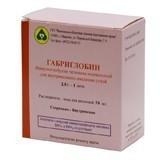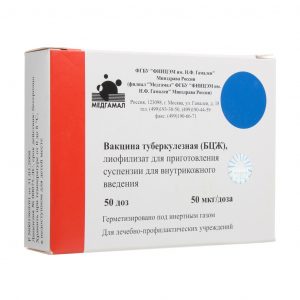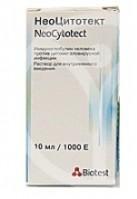Description
Release form
Lyophilisate for solution for i / m administration of white or light yellow color solvent – a clear, colorless liquid the prepared solution is opalescent, colorless or light yellow.
Packaging
Glass bottles (1) complete with solvent (amp. 2 ml 1 pc.) – packs of cardboard.
Pharmacological action
Immunoglobulin. The active component of the drug is specific antibodies against the Rh0 (D) antigen of human red blood cells. The drug prevents isoimmunization in the Rh negative body of a woman, as a result of the fetal blood entering the mother s bloodstream at the birth of a Rh positive child, during spontaneous and induced abortion, in case of amniocentesis or in case of trauma to the abdominal organs during pregnancy.
Anti-D immunoglobulins are polyclonal immunoglobulins whose mechanism of action is to neutralize the Rh0 (D) antigens present in the Rh-positive blood of the embryo. The period of effective action of the drug is on average from 48 to 144 hours, while the highest concentration of human immunoglobulin anti-Rhesus Rh0 (D) is achieved on average 56 hours after drug administration.
The preparation is an immunologically active protein fraction isolated from virus-inactivated human plasma, tested for the absence of antibodies to human immunodeficiency viruses (HIV-1, HIV-2), hepatitis C virus and hepatitis B surface antigen.
Indications
– prevention of anti-D (Rh0) immunization in Rh negative women (Rh0 (D)), not sensitized to Rh0 (D) antigen, and in women with weakly positive Rhesus blood (Du), during pregnancy and the birth of a Rh-positive baby. The drug is used for artificial and spontaneous abortion in Rh-negative women not sensitized to the Rh0 (D) antigen, in the case of Rh-positive blood of the father, as well as amniocentesis, external rotation to the head, trauma to abdominal organs, and prenatal bleeding , ectopic pregnancy and a sample of villous chorion
– prevention of anti-D (Rh0) immunization in Rh-negative patients after incompatible transfusion of Rh-positive blood or erythrocyte concentrate in.
Contraindications
– hypersensitivity to the components of the drug
– sensitized to Rh0 (D) -antigen Rh-positive and Rh-negative women, in the blood serum of which Rh antibodies
were detected – newborns.
Use during pregnancy and lactation
This medicine is used during pregnancy and for 72 hours after birth. No adverse effects were noted on the course of pregnancy, the fetus or the newborn.
Special instructions
I / O should not be administered due to the possibility of shock. The introduction should be in / m. In order to avoid getting the drug into the blood vessels, it is necessary to pull the syringe plunger towards yourself and check for blood in the syringe before starting the drug. True allergic reactions to IM injected human immunoglobulin Rh0 (D) anti-Rhesus are rare. When the first symptoms of the development of anaphylactoid reactions appear, anti-shock therapy is carried out using antihistamines, alpha-adrenergic agonists and GCS.
Immunoglobulin intolerance develops in very rare cases of immunoglobulin A (IgA) deficiency when the patient has anti-IgA antibodies.
Patient monitoring continued for 30-60 minutes after injection. Administration of the drug is immediately discontinued if an allergic or anaphylactic reaction is suspected. In case of shock, anti-shock therapy is used.
After administration of immunoglobulin, a passive increase in the antibody content in the patient ² ¢s blood may be observed, which may lead to an erroneous false-positive interpretation of the results of serological testing. The administration of the human immunoglobulin Rh0 (D) anti-Rhesus significantly influences the results of studies such as the determination of antibodies and blood groups, including the Coombs test and the antiglobulin test.
Virus security. In the manufacture of drugs from human blood or plasma, a set of measures is necessary to prevent the possible transmission of infection to patients. These measures include careful selection of healthy donors, guaranteeing the exclusion of the risk of infection of donors, as well as the control of the blood of each donor and the total plasma pool for the absence of viruses and infections. Each plasma unit used to manufacture the drug is tested for the absence of hepatitis B virus surface antigen and antibodies to human immunodeficiency viruses (HIV-1, 2), to hepatitis C virus. Each plasma pool is also monitored for the absence of hepatitis C virus RNA by polymerase chain reaction. For the manufacture of the drug use only that plasma, which gives negative results for all of the above tests. The production of human blood products also includes the stages of production processing of blood or plasma of a person, allowing inactivation or removal of viruses. Despite this, when using drugs, made from human blood or plasma, the probability of transmission of infection, including unknown or new viruses and other infectious agents, cannot be completely ruled out.
Composition
Composition 1 ml of ready-made solution:
active substance: human plasma proteins containing at least 90% immunoglobulins – 25180 mg [including human immunoglobulin antirhesus Rh0 (D) – 0.15 mg]
auxiliary components: glycine – 22.5 mg sodium chloride – 9 mg solvent: water for injection – up to 1 ml.
Dosage and administration
The solution of the drug is administered in / m.
Postpartum Prevention. 1000-1500 IU (200-300 μg) is recommended as the optimal standard dose without preliminary testing for infiltration of fetal hemoglobin (HbF) into the bloodstream according to the Kleichauer-Betke method. The drug is administered to the mother as soon as possible after childbirth, but no later than 72 hours.
Prenatal and postpartum prophylaxis. The first dose is 1000-1500 IU (200-300 mcg) at the 28th week of pregnancy. The next dose of 1000-1500 IU (200 – 300 μg) is administered within 72 hours after childbirth, if the baby was born Rh-positive.
After abortion, ectopic pregnancy or cystic drift. During the first 72 hours after the intervention, the drug is administered in a dose of 600-750 IU (120-150 μg) before the 12th week of pregnancy 1250-1500 IU (250-300 μg) after 12 weeks of pregnancy 1250-1500 IU (250- 300 mcg) after amniocentesis or chorionic biopsy.
After incompatible transfusion of Rh-positive blood. 500 IU-1250 IU (100-250 mcg) for every 10 ml of transfused blood for several days.
In the case of pathology of the coagulation system, when i / m administration of drugs is contraindicated, human immunoglobulin anti-Rhesus Rh0 (D) can be administered sc. After injection, a compress is carefully applied to the injection site.
If a large total dose (more than 5 ml) is required, it is recommended to divide it into smaller doses and make injections in different places.
Preparation and administration of the
drug solution. Warm the vial with the lyophilisate of the drug and the ampoule with the solvent to room temperature or body temperature. Put the contents of the ampoule with the solvent into the injection syringe, remove the protective cap from the rubber stopper of the vial with the lyophilizate and slowly introduce the solvent into the vial, gently shake the vial with the solution or let stand until the lyophilizate is completely dissolved, put the solution in the syringe, change the needle and make an injection.
Incomplete dissolution of the lyophilisate leads to a loss of activity of the drug. Do not use if solution is cloudy or contains a precipitate. The lyophilisate from the opened vial should be reconstituted and used immediately. The remains of the drug must be destroyed.
Side effects
Local reactions: soreness at the injection site. This can be avoided if a large volume solution is administered in several doses of less than 5 ml in several different places.
Systemic reactions: infrequently – fever, skin reactions, chills rarely – dyspeptic symptoms (nausea and vomiting), decreased blood pressure, tachycardia, allergic or anaphylactic reactions.
Storage conditions
The drug should be stored out of the reach of children and protected from light at a temperature of no higher than 25 ° C. Do not freeze.
The Expiration of
is 3 years.
Pharmacy
Pharmacy Terms
Form of Treatment
simply entails dlya inaektsiy
Kedrion SpA, Italy




